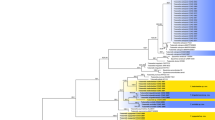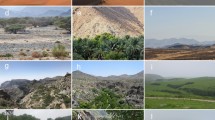Abstract
Aneura pinguis (Aneuraceae) is a cosmopolitan thalloid liverwort that shows a specific mycorrhiza-like interaction with basidiomycetes. To date, tropical specimens have not been studied in great depth. Samples of A. pinguis were collected from 48 individuals in one plot in South Ecuador and 54 individuals in five European countries. Light and transmission electron microscopy and molecular analyses based on nuclear rDNA coding for the ribosomal large subunit (nucLSU) and from the 5.8s-ITS2 regions were carried out to identify the associated mycobionts and to study their phylogenetic relationships. Microscopic and ultrastructural investigations of the fungal colonisation showed a high congruence between the European and the Ecuadorian sites and confirmed previous results. Tulasnellales are the only mycobionts that could be detected from ultrastructural characters with certainty. Molecular phylogenetic analysis indicated the presence of tulasnelloid fungi from at least 13 distinct clades. The composition of the communities of tulasnelloid fungi in A. pinguis differs between Ecuador and Europe. The diversity of tulasnelloid fungal partners was much higher at the Ecuadorian site.




Similar content being viewed by others
References
Altschul SF, Madden TL, Schäffer AA, Zhang J, Zhang Z, Miller W, Lipman DJ (1997) Gapped BLAST and PSI-Blast: a new generation of protein database search programs. Nucleic Acids Res 25:3389–3402
Berbee ML, Taylor JW (2007) Rhynie chert: a window into a lost world of complex plant–fungus interactions. New Phytol 174:475–479
Bidartondo MI, Bruns TD, Weiß M, Sérgio C, Read DJ (2003) Specialized cheating of the ectomycorrhizal symbiosis by an epiparasitic liverwort. Proc R Soc Lond, Ser B 270:835–842
Brown EA, Braggins JE (1989) A revision of the genus Riccardia S.F. Gray in New Zealand. J Hattori Bot Lab 66:1–132
Brundrett MC (2002) Coevolution of roots and mycorrhizas of land plants. New Phytol 154:275–304
Buczkowska K, Adamczak M, Baczkiewicz A (2006) Morphological and anatomical differentiation within the Aneura pinguis complex (Metzgeriales, Hepaticae). Biol Lett 43:51–68
Carafa A, Duckett JG, Knox JP, Ligrone R (2005) Distribution of cell-wall xylans in bryophytes and tracheophytes: new insights into basal interrelationships of land plants. New Phytol 168:231–240
Chambers SM, Williams PG, Seppelt RD, Cairney JWG (1999) Molecular identification of Hymenoscyphus sp. from rhizoids of the leafy liverwort Cephaloziella exiliflora in Australia and Antarctica. Mycol Res 103:286–288
Crandall-Stotler BJ, Stotler RE (2000) Morphology and classification of the Marchantiophyta. In: Shaw AJ, Goffinet B (eds) Bryophyte Bryology. University Press, Cambridge, UK, pp 21–70
Damsholt K (2002) Illustrated Flora of Nordic liverworts and hornworts. Nordic Bryological Society, Lund, Sweden
Davis EC (2004) A molecular phylogeny of leafy liverworts (Jungermanniidae: Marchantiophyta). In: Goffinet B, Hollowell V, Magill R (eds) Molecular systematics of bryophytes. Missouri Botanical Garden Press, St. Louis, USA, pp 61–86
Duckett JG, Ligrone R (2008) Basidiomycetous endophytes in New Zealand Aneuraceae (simple thalloid liverworts, Metzgeriidae) and the derived status of the monotypic genus Verdoornia. Botany 86:346–358
Duckett JG, Burch J, Fletcher PW, Matcham HW, Read DJ, Russell AJ, Pressel S (2004) In vitro cultivation of bryophytes: a review of practicalities, problems, progress and promise. J Bryol 26:3–20
Duckett JG, Carafa A, Ligrone R (2006a) A highly differentiated glomeromycotean association with the mucilage-secreting, primitive antipodean liverwort Treubia (Treubiaceae): clues to the origins of mycorrhizas. Am J Bot 93:797–813
Duckett JG, Russell J, Ligrone R (2006b) Basidiomycetous endophytes in jungermannialean (leafy) liverworts have novel cytology and species-specific host ranges: a cytological and experimental study. Can J Bot 84:1075–1093
Felsenstein J (1985) Confidence limits on phylogenies: an approach using the bootstrap. Evolution 39:83–791
Forrest LL, Davis C, Long DG, Crandall-Stotler BJ, Clark A, Hollingsworth L (2006) Unravelling the evolutionary history of the liverworts (Marchantiophyta): multiple taxa, genomes and analyses. Bryologist 109:303–334
Frey W, Stech M (2005) A morpho-molecular classification of the liverworts (Hepaticophytina, Bryophyta). Nova Hedwig 81:55–78
Gardes M, Bruns TD (1993) ITS primers with enhanced specifity for basidiomycetes—application to the identification of mycorrhizae and rusts. Mol Ecol 2:113–118
Gascuel O (1997) BIONJ: an improved version of the NJ algorithm based on a simple model of sequence data. Mol Biol Evol 14:685–695
Gradstein SR (2001) Liverworts and Hornworts. In: Gradstein SR, Churchill SP, Salazar-Allen N (eds) Guide to the Bryophytes of Tropical America. Memoirs of the New York Botanical Garden 86: pp 70–239
Groth-Malonek M, Pruchner D, Grewe F, Knoop V (2005) Ancestors of trans-splicing mitochondrial introns support serial sister group relationships of hornworts and mosses with vascular plants. Mol Biol Evol 22:117–125
Guindon S, Gascuel O (2003) A simple, fast, and accurate algorithm to estimate large phylogenies by maximum likelihood. Syst Biol 52:696–704
Heinrichs J, Gradstein SR, Wilson R, Schneider H (2005) Towards a natural classification of liverworts (Marchantiophyta) based on the chloroplast gene rbcL. Cryptogam Bryol 26:131–150
Hewson HJ (1970a) The family Aneuraceae in Australia and New Guinea: I. The genus Aneura. Proc Linn Soc N S W 94:173–193
Hewson HJ (1970b) The family Aneuraceae in Australia and New Guinea: II. The genus Riccardia. Proc Linn Soc N S W 95:60–121
Homeier J, Werner FA (2008) Spermatophyta. In: Liede-Schumann S, Breckle SW (eds) Provisional checklists of fauna and flora of the San Francisco valley and its surroundings (Reserva San Francisco/Prov. Zamora–Chinchipe, southern Ecuador). Ecol Monogr 4:15–58
Homeier J, Werner FA, Gradstein SR, Breckle SW, Richter M (2008) Potential vegetation and floristic composition of Andean forests in South Ecuador, with a focus on the RBSF. In: Beck E, Bendix J, Kottke I, Makeschin F, Mosandl R (eds) Gradients in a tropical mountain ecosystem of Ecuador, ecological studies, Vol. 198. Springer, New York, pp 87–100
Karnovsky MJ (1965) A formaldehyde glutaraldehyde fixation of high osmolarity for use in electron microscopy. J Cell Biol 27:137–138
Katoh K, Kuma K, Toh H, Miyata T (2005) MAFFT version 5: improvement in accuracy of multiple sequence alignment. Nucleic Acids Res 33:511–518
Kottke I, Nebel M (2005) The evolution of mycorrhiza-like associations in liverworts: an update. New Phytol 167:330–334
Kottke I, Beiter A, Weiß M, Haug I, Oberwinkler F, Nebel M (2003) Heterobasidiomycetes form symbiotic associations with hepatics: Jungermanniales have a sebacinoid mycobionts while Aneura pinguis (Metzgeriales) is associated with a Tulasnella species. Mycol Res 107:957–968
Kottke I, Haug I, Preußing M, Setaro S, Suárez JP, Weiß M, Nebel M, Oberwinkler F (2008) Guilds of mycorrhizal fungi and their relation to trees, ericads, orchids and liverworts in a neotropical mountain rain forest. Basic Appl Ecol 9:13–23
Ligrone R, Pocock K, Duckett JG (1993) A comparative ultrastructural study of endophytic basidiomycetes in the parasitic achlorophyllous hepatic Cryptothallus mirabilis and the closely allied photosynthetic species Aneura pinguis (Metzgeriales). Can J Bot 71:666–679
Long DG, Hollingsworth PM, Forrest LL (2007) Barcoding Britain’s liverworts and hornworts: a new project and request for material. Field Bryol 93:10–13
McKenna DD, Farrell BD (2006) Tropical forests are both evolutionary cradles and museums of leaf beetle diversity. Proc Natl Acad Sci U S A 103:10947–10951
Moncalvo JM, Nilsson RH, Koster B, Dunham SM et al (2006) The cantharelloid clade: dealing with incongruent gene trees and phylogenetic reconstruction methods. Mycologia 98:937–948
Nebel M, Kreier HP, Preußing M, Weiß M, Kottke I (2004) Symbiotic fungal associations of liverworts are the possible ancestors of mycorrhizae. In: Agerer R, Piepenbring M, Blanz P (eds) Frontiers in Basidiomycote mycology. IHW-Verlag, Eching, Germany, pp 339–360
Nöske NM, Gradstein SR, Kürschner H, Parolly G, Torracchi S (2003) Cryptogams of the Reserva Biológica San Francisco (Province Zamora-Chinchipe, Southern Ecuador) I. Bryophytes. Cryptogam Bryol 24:15–32
O’Donnell K (1993) Fusarium and its near relatives. In: Reynolds DR, Taylor JW (eds) The fungal holomorph: mitotic, meiotic and pleomorphic speciation in fungal systematics. CAB International, Washington, DC, USA, pp 225–233
Parolly G, Kürschner H, Schäfer-Verwimp A, Gradstein SR (2004) Cryptogams of the Reserva Biológica San Francisco (Province Zamora-Chinchipe, Southern Ecuador) III. Bryophytes—additions and new species. Cryptogam Bryol 25:271–289
Pressel S, Davis EC, Ligrone R, Duckett JG (2008) A novel ascomycetous endophytic association in the rhizoids of the leafy liverwort family, Schistochilaceae (Jungermanniidae, Hepaticopsida). Am J Bot 95:531–541
Rambaut A, Drummond AJ (2004) Tracer. MCMC Trace Analysis Tool, version 1.2.1. University of Oxford, UK http://evolve.zoo.ox.ac.uk/software.html
Read DJ, Duckett JG, Francis R, Ligrone R, Russell A (2000) Symbiotic fungal associations in ‘lower’ land plants. Philos Trans R Soc Lond, Ser B 355:815–831
Roberts P (1999) Rhizoctonia-forming fungi. A taxonomic guide. The Herbarium, Royal Botanic Gardens, Kew, England
Ronquist F, Huelsenbeck JP (2003) MrBayes 3: Bayesian phylogenetic inference under mixed models. Bioinform 19:1572–1574
Russell J, Bulman S (2005) The liverwort Marchantia foliacea forms a specialized symbiosis with arbuscular mycorrhizal fungi in the genus Glomus. New Phytol 165:567–579
Schuster RM (1984) Evolution, phylogeny and classification of the hepaticae. In: Schuster RM (ed) New manual of bryology. The Hattori Botanical Laboratory, Nichinan, Miyazaki, Japan, pp 892–1070
Schuster RM (1992) The Hepaticae and Anthocerotae of North America east of the hundredth meridian, Vol. V. Field Museum of Natural History, Chicago, USA
Selosse MA, Le Tacon F (1998) The land flora: a phototroph-fungus partnership? Trends Ecol Evol 13:15–20
Shefferson RP, Taylor DL, Weiß M et al (2007) The evolutionary history of mycorrhizal specificity among lady’s slipper orchids. Evolution 61–6:1380–1390
Spurr AR (1969) A low-viscosity epoxy resin embedding medium for electron microscopy. J Ultrastruct Res 26:31–43
Stahl M (1949) Die Mycorrhiza der Lebermoose mit besonderer Berücksichtigung der thallosen Formen. Planta 37:103–148
Suárez JP, Weiß M, Abele A, Garnica S, Oberwinkler F, Kottke I (2006) Diverse tulasnelloid fungi form mycorrhizas with epiphytic orchids in an Andean cloud forest. Mycol Res 110:1257–1270
Szweykowski J (1968) Atlas of geographical distribution of spore-plants in Poland. Serie IV. Liverworts (Hepaticae). Part V. Poznan, Poland
Taylor DL, McCormick MK (2008) Internal transcribed spacer primers and sequences for improved characterization of basidiomycetous orchid mycorrhizas. New Phytol 177:1020–1033
Upson R, Read DJ, Newsham KK (2007) Widespread association between the ericoid mycorrhizal fungus Rhizoscyphus ericae and a leafy liverwort in the maritime and sub-Antarctic. New Phytol 176:460–471
Vilgalys R, Hester M (1990) Rapid genetic identification and mapping of enzymatically amplified ribosomal DNA from several Cryptococcus species. J Bacteriol 172:4238–4246
Wachowiak W, Baczkiewicz A, Chudzinska E, Buczkowska K (2007) Cryptic speciation in liverworts—a case study in the Aneura pinguis complex. Bot J Linn Soc 155:273–282
Wang B, Qiu Y-L (2006) Phylogenetic distribution and evolution of mycorrhizas in land plants. Mycorrhiza 16:299–363
Wellman C, Osterloff PL, Mohiuddin U (2003) Fragments of the earliest land plants. Nature 425:282–285
Wickett NJ, Goffinet B (2008) Origin and relationships of the myco-heterotrophic liverwort Cryptothallus mirabilis Malmb. (Metzgeriales, Marchantiophyta). Bot J Linn Soc 156:1–12
Acknowledgements
We thank Ingrid Kottke, whose commitment was essential in the beginning of the project. Robert Bauer provided valuable information on ultrastructural features of tulasnelloid fungi. Renate Lübenau-Nestle gave us indispensable help when collecting Aneura samples in Bavaria; Lars Hedenäs, Eva Maier, and Michael Sauer also supported the investigations by sampling. We thank A. Kei Andrews for critically reading an earlier draft of the manuscript. This study was carried out within the research project FOR 402-2, financially supported by the Deutsche Forschungsgemeinschaft (DFG; German Research Association). We thank the Fundación Cientifíca San Francisco and the NCI for providing research facilities.
Author information
Authors and Affiliations
Corresponding author
Rights and permissions
About this article
Cite this article
Preußing, M., Nebel, M., Oberwinkler, F. et al. Diverging diversity patterns in the Tulasnella (Basidiomycota, Tulasnellales) mycobionts of Aneura pinguis (Marchantiophyta, Metzgeriales) from Europe and Ecuador. Mycorrhiza 20, 147–159 (2010). https://doi.org/10.1007/s00572-009-0275-9
Received:
Accepted:
Published:
Issue Date:
DOI: https://doi.org/10.1007/s00572-009-0275-9




